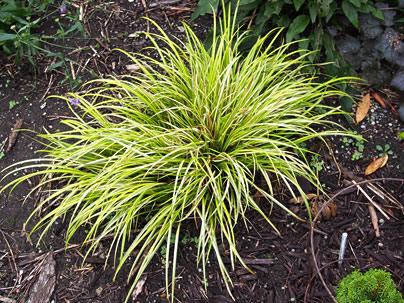The Japanese Sweet Flag (Acorus gramineus) is a herbaceous, rhizomatous plant that, at first glance, resembles grass (Poaceae). However, it is not a true grass and belongs to its own family, Acoraceae. From its thick rhizomes emerge lanceolate, shiny, slightly curved, aromatic, and green leaves in the typical species. However, there are various cultivars for ornamental use, ranging in size, with leaves that vary in fragrance, variegated with white, and plants with attractive yellow foliage.
Among these, we can mention ‘Ogon,’ ‘Variegatus,’ ‘Licorice,’ and ‘Pusillus.’ It only blooms when cultivated as an aquatic plant, with the rhizome submerged in water. The inflorescences are of the spadix type, discreet, white, located at the base of the clump, and of little ornamental importance. The ensuing fruits are tiny, fleshy berries of a red color.
Use Japanese sweet flag in pots, as ground cover for taller species, and in mixed beds in partial shade, especially in areas with drainage problems. It is also interesting around ponds and watercourses, serving as a marsh or marginal plant, providing refuge for fauna such as small fish and frogs.
Its attractive and shiny foliage and the small rounded bush shape help soften the often sharp and rocky edges of artificial lakes. It tolerates light trampling and releases a pleasant aroma, reminiscent of tangerine and anise, when its leaves are crushed. It can also be used in closed terrariums, as it appreciates constant humidity.
It should be grown in full sun or partial shade, in fertile soil enriched with organic matter, and kept consistently moist. When the leaf tips become dry and brown, and the plant wilts frequently, it is a sign that the soil is too dry. In this case, add more organic matter, mulch, and water more frequently.
In gardens and in warm climates, prefer planting Japanese sweet flag under partial shade conditions, as otherwise, the foliage may look unsightly. In lakes and in temperate climates, full sun conditions will be beneficial. It multiplies by dividing clumps in late winter, ensuring that each new plant has the complete structure, including roots, rhizome, and leaves.


